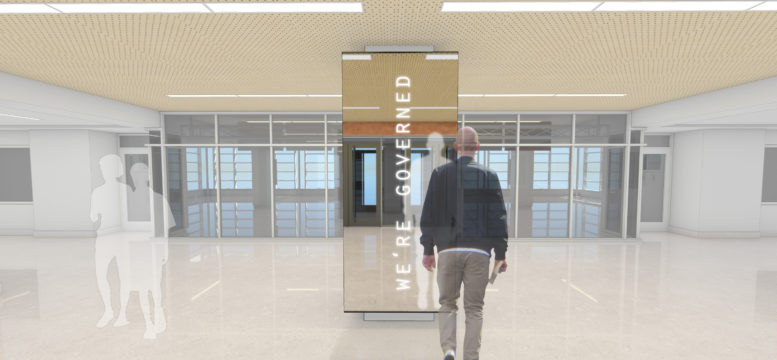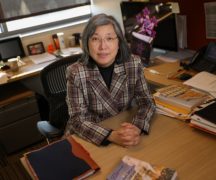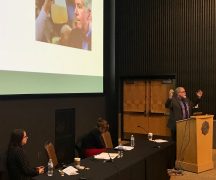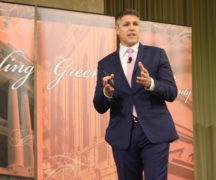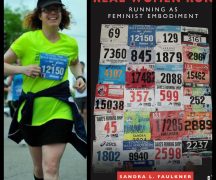By DAVID DUPONT
BG Independent News
It’s hard to get away from the gaze of the four-sided column of mirrors planted in the entryway of the Kuhlin Center. The artwork, Medium, will have students and professors reflecting on their vocations.
Medium is a four-sided pillar with two-way mirrors on each side, and a projector as a hidden presence within. The mirrors will capture on the buzz of activity in the lobby of the center, and scrolling down the center of each mirror will be a randomly selected statement starting with either “we” or “they.”
Recently artist Erik Carlson, who created the piece, was in the lobby putting finishing touches on the work in the new home for Bowling Green State University’s School of Media and Communication. At this point what’s reflected is the mess of construction, ladders, buckets, drop cloths, packing boxes and the like. Assisting him is Nicholas Hanna, a Los Angeles computer programmer.
Carlson, whose studio Area C is in Rhode Island, said the concept is to mediate the media experience and have students consider what their role as future professionals is in the process of gathering, disseminating and consuming information. The “we” is those who produce and deliver the news. And the “they” are those who are the subject of the news and the consumers. Smack in the middle will be the “I,” the students and faculty learning and teaching about this process. As they read the statement they can consider themselves on both sides. All the while they will be staring themselves in the face.
Carlson said that the concept came about as he thought about what the building would be used for. When he discovered that the University Library had a digital archive of The BG News dating back to 1921, he knew he wanted to tap that rich resource. The archive became one of two sources for those “we” and ‘they” phrases.
The other is the closed-captioning for the live feed of whatever is going out over WBGU-TV’s main station.
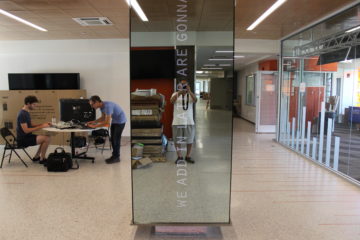
Nicholas Hanna, left, and Eric Carlson work on the installation of Medium.
On this Saturday, the station is broadcasting a show about beer making. The phrases “WE GET IN ALL THE WORT” and “WE DON’T WANT TO GRIND IT DOWN” scroll from bottom to top on a screen, the words, starting with “WE” slowly becoming visible. They blink a little, a sign that this is a live phrase.
Then a phrase from the archives rolls by: “THEY MUST HAVE KNOWN MICKEY WAS A MOUSE.”
The rate at which they appear and fade varies, though each lasts about 30 seconds, Carlson said.
Hanna was charged with doing the programming to cull these phrases from the archive. Finding the phrases of just the right length to fit on the screen, and still make some sense.
They came up with about 300,000 from the archive. Carlson and Erica Carpenter, his wife who is a poet, edited those down to about 50,000.
So many of the phrases, Carlson said, were sports related, so they eliminated many of those, and others were taken out because they were too dependent on other words to make any sense.
The idea is for the phrase to be more or less complete, but stripped of all context. This can make the most innocuous phrase, as it emerges from some other worldly place, seem ominous, or maybe humorous, or perplexing, or just plain weird. They pose the question where does the person stand in this divide between “they” and “we,” or us and them. Each viewer is on both sides, and yet in the middle.
At any given time two phrases will be scrolling, with the same phrase on opposite sides of the column. At a rate of 30 second for each phrase the art work will cycle through 5,760 phrases a day. That means in time phrases from the archive will be recycled, but the order and juxtapositions will always be random.
The work is being paid for through the state’s Percent for Art program which sets aside 1 percent of any project over $4 million for art work.
The Kuhlin Center is set to be open when classes resume Aug. 22.

